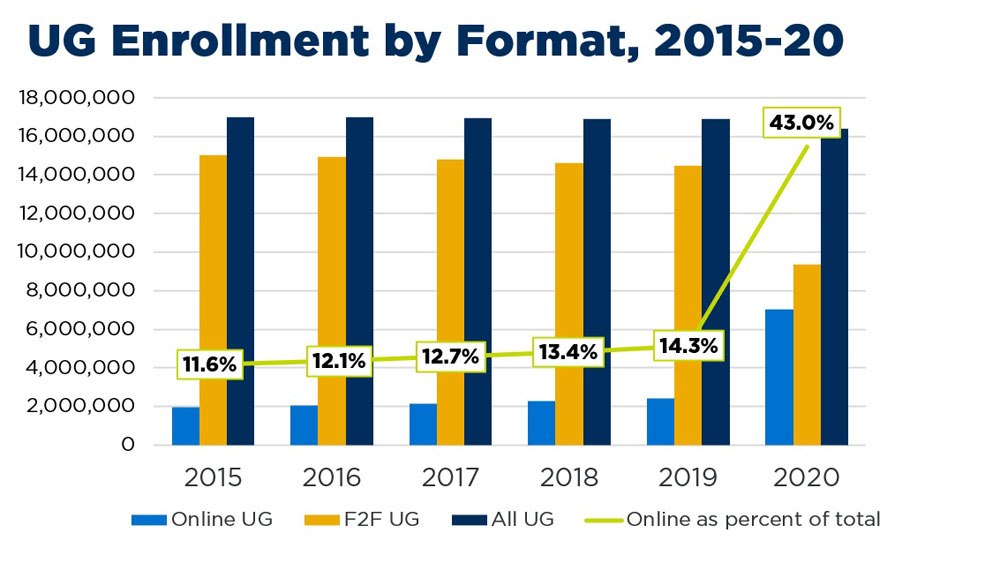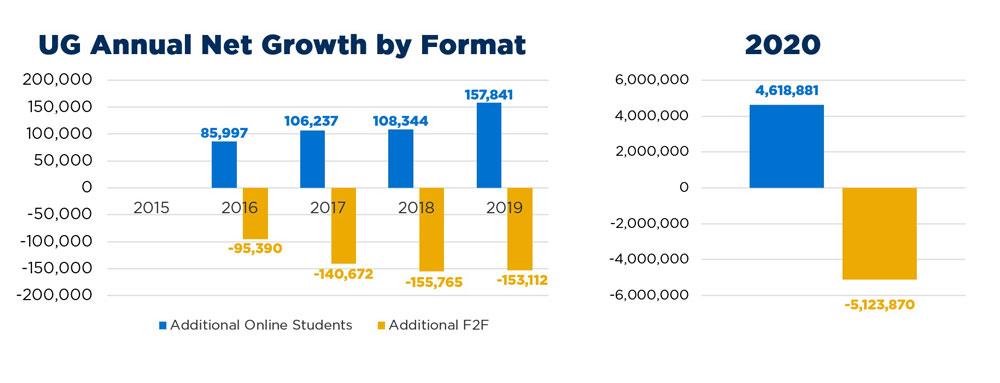enrollment
The Unexpected Impact of Online Education on Undergraduate Enrollment Growth
If someone had told me a month ago that there had been NO growth in classroom undergraduate study in the pre-pandemic years 2015-19, I would have felt the need to verify the data myself. Well, someone said just such a thing and I DID verify the data, and she was correct.
This statement prodded me to analyze the NCES fall enrollment at both the undergrad and graduate levels. In addition, the graduate findings also demonstrate that all graduate growth between 2015 and 2019 (and of course 2020) was derived from expansion of online program enrollment.
Undergraduate enrollment patterns
Online students comprise a far smaller proportion of undergraduate enrollment than they do at the graduate level— 14.3 percent of fall enrollment in 2019 compared with 32.2 percent. However, in total numbers far more undergraduates (2.4 million) than graduate students (989,000) were enrolled in “all distance courses” (in NCES parlance).
Of course the pandemic upended these data in a dramatic fashion—catapulting the number of undergraduate students enrolled in fully online study to almost 7.1 million, or 43 percent of all enrolled students. Among the remaining 57 percent, more were enrolled in “one or more distance courses” than “no distance courses”—another clear result of the pandemic.
These fall enrollment data demonstrate that fully online programs are on the rise and have been the only thing mitigating further declines in total undergraduate enrollment (portrayed in the dark blue bars below).

What does this mean? The pre-pandemic trends showing an increase of more than 450,000 fully online students between 2015 and 2019 occurred while the balance of the undergraduate population contracted by more than 540,000. The dramatic rises in 2020 are unlikely to continue, but it is equally unlikely that the online proportion will return to the mid-teens now that the vast majority of students have been exposed to the many advantages of online study.
Annual net growth by format
The original instigator of this inquiry—the speaker I heard that said that there had been no increase in classroom study since at least 2014—inspired me to develop a visualization of this divergence in the fortunes of classroom versus online study. What follows provides as clear a picture of this divergence as I could conceive.
In the charts below, the blue bars portray year-over-year (YoY) changes in online enrollment. The orange bars portray YoY changes in classroom enrollment (or “some distance courses”). These figures show how essential online programs are to enrollment health. The 2020 graph below has purposely separated that year from the previous five years due to the dramatic change in the magnitude of the online numbers.

What does this mean? Over the last decade I have urged many clients to add at a minimum partially online options to their program mix. I have done this not because I didn’t see the dramatic expansion of the fully online market, but because on many campuses there was such distaste for fully online programs (particularly at the undergraduate level) that the best way forward was to “get their feet wet” with these blended options. Once that was done, the stakeholders would hopefully gain confidence in the efficacy of online learning. However, I am no longer saying this. Although programs that offer the opportunity to take “one or more distance courses” are surely shoring up those orange bars, they are not preventing overall contraction. Only fully online enrollment is growing, and therefore institutions that cannot figure a way forward with expanded online offerings may have to plan for a smaller future.
What’s the best way forward for your enrollment growth? Let’s discuss.
If you’d like to talk with an RNL consultant about the details of online program demand in your region—and how we help institutions meet the specific demands of online students in their region—contact us today. We can prepare a regional data set for you and talk through the implications for your institution.
Find the optimal online enrollment strategy
Talk with RNL’s online enrollment experts about finding the right strategy for your institutions and programs. We can discuss research, digital lead generation, online curriculum enablement, and more.
